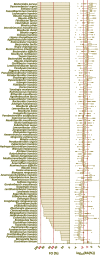Enlightening the taxonomy darkness of human gut microbiomes with a cultured biobank
- PMID: 34020714
- PMCID: PMC8140505
- DOI: 10.1186/s40168-021-01064-3
Enlightening the taxonomy darkness of human gut microbiomes with a cultured biobank
Erratum in
-
Correction: Enlightening the taxonomy darkness of human gut microbiomes with a cultured biobank.Microbiome. 2022 Oct 3;10(1):163. doi: 10.1186/s40168-022-01370-4. Microbiome. 2022. PMID: 36192813 Free PMC article. No abstract available.
Abstract
Background: In gut microbiome studies, the cultured gut microbial resource plays essential roles, such as helping to unravel gut microbial functions and host-microbe interactions. Although several major studies have been performed to elucidate the cultured human gut microbiota, up to 70% of the Unified Human Gastrointestinal Genome species have not been cultured to date. Large-scale gut microbial isolation and identification as well as availability to the public are imperative for gut microbial studies and further characterizing human gut microbial functions.
Results: In this study, we constructed a human Gut Microbial Biobank (hGMB; homepage: hgmb.nmdc.cn ) through the cultivation of 10,558 isolates from 31 sample mixtures of 239 fresh fecal samples from healthy Chinese volunteers, and deposited 1170 strains representing 400 different species in culture collections of the International Depository Authority for long-term preservation and public access worldwide. Following the rules of the International Code of Nomenclature of Prokaryotes, 102 new species were characterized and denominated, while 28 new genera and 3 new families were proposed. hGMB represented over 80% of the common and dominant human gut microbial genera and species characterized from global human gut 16S rRNA gene amplicon data (n = 11,647) and cultured 24 "most-wanted" and "medium priority" taxa proposed by the Human Microbiome Project. We in total sequenced 115 genomes representing 102 novel taxa and 13 previously known species. Further in silico analysis revealed that the newly sequenced hGMB genomes represented 22 previously uncultured species in the Unified Human Gastrointestinal Genome (UHGG) and contributed 24 representatives of potentially "dark taxa" that had not been discovered by UHGG. The nonredundant gene catalogs generated from the hGMB genomes covered over 50% of the functionally known genes (KEGG orthologs) in the largest global human gut gene catalogs and approximately 10% of the "most wanted" functionally unknown proteins in the FUnkFams database.
Conclusions: A publicly accessible human Gut Microbial Biobank (hGMB) was established that contained 1170 strains and represents 400 human gut microbial species. hGMB expands the gut microbial resources and genomic repository by adding 102 novel species, 28 new genera, 3 new families, and 115 new genomes of human gut microbes. Video abstract.
Keywords: Biobank; Cultivation; Human gut microbiomes; Novel taxa; hGMB.
Conflict of interest statement
The authors declare no competing interests.
Figures




References
Publication types
MeSH terms
Substances
LinkOut - more resources
Full Text Sources
Other Literature Sources
Molecular Biology Databases

